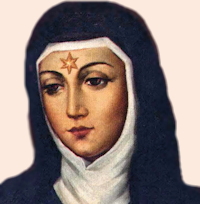Ordinary Time: August 17th
Monday of the Twentieth Week of Ordinary Time
Other Commemorations: Our Lady of Knock (Ireland); St. Beatrice of Silva, Religious (RM); St. Nicholas Politi, Hermit (RM); Bl. Marie Elisabeth Turgeon, Religious (RM)
Free eBook:
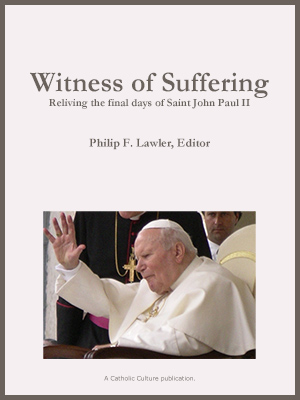
|
| Free eBook: Witness of Suffering |
» Enjoy our Liturgical Seasons series of e-books!
According to the 1962 Missal of St. John XXIII the Extraordinary Form of the Roman Rite, today is the feast of St. Hyacinth, a canon of Krakow, who joined the Dominican Order in Rome during the lifetime of the founder, in about the year 1217. He returned to Krakow with the first band of Dominican missionaries. The newcomers spread over all the northern countries into Russia, the Balkans, Prussia and Lithuania. St. Hyacinth preached the crusade against the Prussians. He died on the feast of the Assumption, 1257.
St. Beatrice of Silva
St. Beatrice was born in Campo Mayor, Portugal, around 1424. She was the daughter of Rodrigo Gómez de Silva and Isabella de Meneses, who had eleven children in all. Both were descendants of noble families, related to the royal houses of Spain and Portugal. One of their children, the fifth in the order of birth, was Blessed Amedeo de Silva, founder of the Amadeites, a reformed branch that later rejoined the Order of Friars Minor.
Beatrice spent her childhood and adolescence in Campo Mayor, where her father had moved from Ceuta before her birth. Her mother, very fond of the Friars Minor, wanted some of them to take care of the education of her children. At the same time, they taught the boys a special devotion to the Immaculate Conception of the Virgin Mary. The Franciscan Order, in fact, defended that particularity of the Madonna, in contrast with those who, instead, claimed that she had not been preserved from original sin (the so-called macolatists).
A legend tells that Beatrice's father had commissioned an Italian painter to paint the Madonna with the Child Jesus in her arms, flanked by Saint Francis of Assisi and Saint Anthony of Padua. The painter, who arrived at the nobleman's residence, asked him to use Beatrice herself as a model. The young woman accepted her, but during the time she posed she never opened her eyes, due to her modesty that she felt because her features would be reproduced as the basis for those of the Virgin. That painting is still known today as "The Virgin with closed eyes".
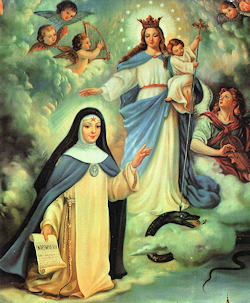 In 1447, at the age of about twenty, Beatrice accompanied the Infanta Isabella of Portugal as a lady-in-waiting on the occasion of her wedding with John II of Castile. The court of Castile, which at the time was located in Tordesillas, was characterized by intrigue and courtesy, in the midst of which the young lady felt uneasy. Her beauty and her virtue attracted the Castilian nobles, who fought for her friendship and her love. This aroused the jealousy of Isabella who mistreated her, until she locked her in a locked chest for three days, without giving her food or drink, putting her at risk of losing her life. During her confinement, Beatrice invoked the Madonna, who appeared to her, dressed in white and blue, inviting her to found a religious order that would support her Immaculate Conception, whose members would wear a dress similar to hers. To return that gift, the young woman chose to take a vow of perpetual virginity.
In 1447, at the age of about twenty, Beatrice accompanied the Infanta Isabella of Portugal as a lady-in-waiting on the occasion of her wedding with John II of Castile. The court of Castile, which at the time was located in Tordesillas, was characterized by intrigue and courtesy, in the midst of which the young lady felt uneasy. Her beauty and her virtue attracted the Castilian nobles, who fought for her friendship and her love. This aroused the jealousy of Isabella who mistreated her, until she locked her in a locked chest for three days, without giving her food or drink, putting her at risk of losing her life. During her confinement, Beatrice invoked the Madonna, who appeared to her, dressed in white and blue, inviting her to found a religious order that would support her Immaculate Conception, whose members would wear a dress similar to hers. To return that gift, the young woman chose to take a vow of perpetual virginity.
Once freed by the intervention of her uncle, Giovanni Meneses, she obtained permission to leave the court and left for Toledo, accompanied by two bridesmaids. Along the way she was flanked by two friars, whom she recognized as St. Francis of Assisi and St. Anthony of Padua, who appeared to give her courage. From then on she had a great devotion to them and celebrated their liturgical feasts with solemnity.
Once in Toledo, she entered the Dominican monastery of San Domenico "El Real", where she lived for about thirty years as a boarder, that is, without taking vows. During that time, she continued to reflect on how to keep the promise of founding the new religious order in honor of the Immaculate Conception. For this purpose, she obtained the support of Queen Isabella, known as the Catholic, daughter of John II, and Isabella of Portugal. The sovereign gave her her palace in Galiana in Toledo, with the adjoining church of Santa Fe. Beatrice, in 1484, moved to the new residence with twelve companions, thus starting a new monastic family, approved by Pope Innocent VIII on April 30, 1489, with the bull "Inter Universa".
There are conflicting sources about her death. Some claim that she died on August 17, 1490, without professing vows. Others, on the other hand, declare that she died in 1492, after having professed together with the first group of the new Order. Her ancient biographies tell that, when she was removed from her veil to receive the Anointing of the Sick, a very bright star appeared in the middle of her forehead, which went out only when she passed away. It later became one of her iconographic attributes.
Beatrice's reputation for holiness spread spontaneously in Spain and beyond. In the calendars of the Franciscan, Cistercian and Benedictine orders she appeared with the title of "Blessed", while she was attributed numerous graces. Even at her tomb, in the Conceptionist monastery of Toledo, many faithful came to pray. However, after the decrees of Urban VIII, she could no longer receive public worship. Nevertheless, her fame did not fail, so much so that, on July 28, 1926, Pope Pius XI officially declared her Blessed, confirming the immemorial cult she enjoyed and fixing her liturgical memory to August 17, the presumed day of the birth of she to Heaven. She was canonized by Pope Paul VI on October 3, 1976.
—Excepted from Santi Beati
Patronage: prisoners; Conceptionist Nuns
Highlights and Things to Do:
- Read more about St. Beatrice:
- Find out more about the religious order Order of the Immaculate Conception (Ordo Inmaculatae Conceptionis), also known as the Conceptionists founded by St. Beatrice.
- Pray this prayer in honor of St. Beatrice.
St. Nicolas Politi
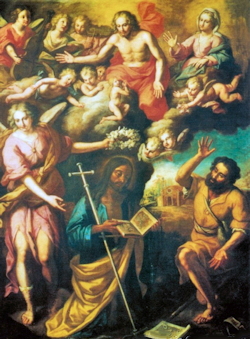 St. Nicholas Politi, born in the twelfth century in Sicily in the city of Adrano, remained a virgin in mind and body with prayer, penance and hermit life for some time on the slopes of Etna and then at the Calanna in the Nebrodi Mountains at Alcara li Fusi.
St. Nicholas Politi, born in the twelfth century in Sicily in the city of Adrano, remained a virgin in mind and body with prayer, penance and hermit life for some time on the slopes of Etna and then at the Calanna in the Nebrodi Mountains at Alcara li Fusi.
Anchorite and Hesychast, he enriched his existence weekly by participating in the cenobitic life at the Byzantine monastery of the Holy Mother of God at the Rogato Monastery, confessing and feeding on the Holy Eucharist.
After having given his sweet soul to Heaven, his body was found on his knees by a good man named Leone Rancuglia on August 17, inside a cavern between the slopes of Monte Calanna, near Alcara li Fusi.
Two women gave testimony of him who some time before his death had met him begging for some pears that they carried along the way.
Portentous prodigies accompanied his death, his discovery and the transport of his body to the land of Alcara and the decision, by divine will, to place it at the Rogato church.
The categumeno (Italian-Greek abbot monk) Cusmano Theologian, who was honored to have known the great penitential fervor of the saint during his life, composed a hymn in Greek to celebrate his virtues, faith, heroism, miracles and holiness.
A contemporary monk extensively narrated his life. The sanctity was also celebrated in some liturgical passages of the Italo-Greek office of the twelfth century.
On the occasion of his powerful patronage, which took place on May 10, 1503 with numerous prodigies, conversions and miraculous healings, his fame spread greatly.
Highlights and Things to Do:
- Read more about St. Nicholas:
- Visit the Official site of the 111 year old Society of San Nicolò Politi where an annual Mass and celebration take place at St. Rocco Parish.
Bl. Marie Elisabeth Turgeon
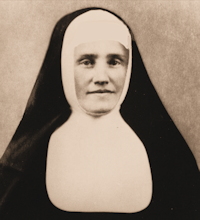 Elisabeth Turgeon was born on February 7, 1840, in Beaumont (Quebec), the fifth of a family of ten children. A gifted student, she wanted to continue her education, but the death of her father when she is only fifteen, lead her to help her mother to bring up her four younger sisters. When she was twenty years old, Elisabeth was allowed to go to the Ecole Normale in Laval to prepare to become a teacher. She obtained her diploma and in 1863 became the principal of a school near her family home. Her bad health forced her to quit at the end of the school year, in 1872. She then opened a private class in Saint Roch, but once again was unable to continue.
Elisabeth Turgeon was born on February 7, 1840, in Beaumont (Quebec), the fifth of a family of ten children. A gifted student, she wanted to continue her education, but the death of her father when she is only fifteen, lead her to help her mother to bring up her four younger sisters. When she was twenty years old, Elisabeth was allowed to go to the Ecole Normale in Laval to prepare to become a teacher. She obtained her diploma and in 1863 became the principal of a school near her family home. Her bad health forced her to quit at the end of the school year, in 1872. She then opened a private class in Saint Roch, but once again was unable to continue.
She therefore turned to Saint Anne and promised to teach for free if Saint Anne heals her. As she fulfilled this promise, Father Langevin, who was named Bishop of Rimouski, asked her to direct the small community of teachers that was being formed in his diocese. She hesitated because of her poor health, but ended up accepting because she believed it is God’s will for her to enter religious life. With other young women she formed the first group of the Soeurs des Petites Ecoles, dedicated to the education of the poor children of the surrounding countryside. On September 12, 1879, Elisabeth and twelve other sisters took their vows. Marie-Elisabeth was made superior and committed herself to establish the community of sisters and regularized its status (civil charter, constitutions, rule). She founded the community’s first mission on January 2, 1880 and two others the following September, in outlying and poor parts of the Diocese of Rimouski. Then she opened a private school in Rimouski, where the novices had their first teaching experience.
Charity was the unifying principle in Elisabeth’s life. She offered love to everyone, especially to her sisters, by being very attentive with them and always filled with goodness. Despite her poor health, she showed extraordinary strength: she worked day and night and overcame difficulties with patience and joy. She died on August 17, 1881, only 41 years old. She was beatified on April 26, 2015.
—Excerpted from CRC
Highlights and Things to Do:
- Read more about her life:
- Find out about the religious order founded by Blessed Marie-Elisabeth: Congregation of the Sisters of Our Lady of the Rosary.




